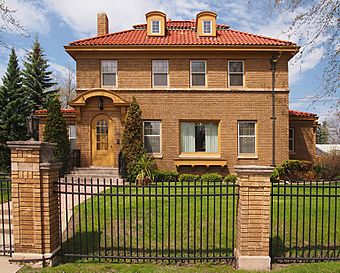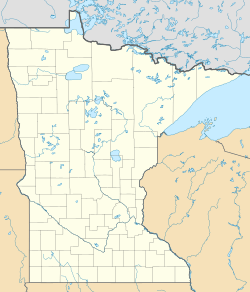Andrew G. Anderson House facts for kids
Quick facts for kids |
|
|
Andrew G. Anderson House
|
|

The Andrew G. Anderson House viewed from the south
|
|
| Location | 1001 E. Howard Street, Hibbing, Minnesota |
|---|---|
| Area | Less than one acre |
| Built | 1920 |
| Architect | J.C. Taylor |
| Architectural style | Colonial Revival/Spanish Colonial Revival |
| NRHP reference No. | 80004348 |
| Added to NRHP | December 4, 1980 |
The Andrew G. Anderson House is a special old house in Hibbing, Minnesota. It was built in 1920 for Andrew "Bus Andy" Anderson. He was a very important person who helped start the first bus services between cities.
This house is listed on the National Register of Historic Places. This means it is a historically important building. It was chosen because of its unique design and its connection to how people started traveling by bus. It was also one of the fanciest homes in the Hibbing area back then.
What Does the Anderson House Look Like?
The Andrew G. Anderson House is a two-story building. It is made of cream-colored bricks. The house sits on a large, well-kept yard on East Howard Street. This street is a main road in Hibbing.
The house has a mix of two cool styles: Colonial Revival and Spanish Colonial Revival architecture. Even its garage has these styles! The roof is covered with Spanish tiles and slopes down on all sides (a hip roof). It also has two small windows that stick out from the roof (called dormers). Copper pipes (called downspouts) help drain water from the roof.
The main door is on the left side of the front of the house. A sun porch, which is a room with many windows, sticks out from the side. A fancy wrought iron fence with brick posts goes all around the property.
Who Was "Bus Andy" Anderson?
Andrew Anderson, known as "Bus Andy," was a pioneer in transportation. In the 1910s, he and two friends started a regular bus service. Their first route was between Hibbing and nearby Alice, Minnesota.
At that time, most people traveled by train. Trains were seen as more comfortable and safer. But Anderson and his partners kept going. The local economy was strong because of iron mining. So, more and more people needed to travel.
Anderson and his team grew their business. They added more routes and buses. They connected towns in the Iron Range area. This became one of the first networks of buses traveling between cities in the United States. Even though Anderson's main business stayed local, the company he helped start eventually became Greyhound Lines, a very famous bus company!
See Also



